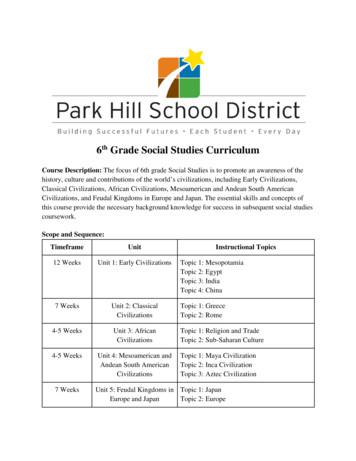Ancient Civilizations - Weebly
ANCIENTCIVILIZATIONSMr. StilleWHAPSunday, August 25, 13
Review QuestionHow did the Neolithic Revolution changethe nature of human society?Sunday, August 25, 13
Focus QuestionWhat components must a society have inorder to be considered a civilization?Sunday, August 25, 13
Location of Ancient CultureHearthsWhat environmental conditions wereneeded to develop the first civilizations?Sunday, August 25, 13
Ancient MesopotamiaSunday, August 25, 13
Government Initially, priest-kings rulecity-states City-states evolve intoempires Sumerians (c. 3500 BCE)Akkadians (c. 2334-2218BCE)Land owning aristocracydominatedDevelop a formal legalcodesSunday, August 25, 13
Religion Believed in 3,000 godsGoal: Appease gods tocontrol natureArt and literature focuson gods and religion Epic of Gilgamesh Contains a story of an epicfloodBuilt zigguratsSunday, August 25, 13
Society One could become aslave through war,crime, or debt Slaves were used intemples, publicbuildings, or privatehomes NoblesFreemenSlavesSunday, August 25, 13Social stratificationSlavery was common Patriarchal Women could holdmost occupations
EconomySunday, August 25, 13
Science & Technology Inventions: wheel,sail, and plowBronze metallurgy1st system ofwriting 1st number system CuneiformBased on units of10, 60, & 360AstronomySunday, August 25, 13
Ancient Egypt Relatively isolatedNile flooded regularly,predictablyProvided rich soil, easysoil to farm Civilization regulatedflooding, surveying Control the Nile;control societySunday, August 25, 13
Government Formed by 3000 BCEUnified for most ofhistoryEarly Kingdom Middle Kingdom Late Kingdom TheocracyPharaoh was a god-king Women could bepharaohs Ramses IISunday, August 25, 13 Hatshepsut (1473-1458
Religion Thousands of godsGods have animal andhuman qualities Gods & goddesses Relatively egalitarianBelieve in afterlifeHeaven & Hell Mummification Pyramids & Temples Sunday, August 25, 13
Society Social Stratification Limited opportunityfor social mobilitySlavery commonWomen have morerights Could own property,propose marriage,and demand a divorceSunday, August 25, 13
Culture Hieroglyphicwriting on papyrusMathematics Calendar system Geometry365 days (off by 6hours)MedicineArchitectureSunday, August 25, 13
Ancient India & ChinaSunday, August 25, 13
Indus River Valley Cities emergearound 2500 BCECulturally unifiedcity-states Harappa andMohenjo-DaroMysterious ending Environmentaldegradation vs.Aryan invasionSunday, August 25, 13
Indus River Valley Polytheisticreligion Planned cities withlarge templesUndecipherablewriting systemAdvancedtechnology Sunday, August 25, 13InfluencedHinduismPlumbing systems
Ancient China Developed inisolation along theHuang He (Yellow)RiverShang dynastyemerged c. 1500BCEWarlike kings &landed aristocracydominate Cities surrounded Sunday, August 25, 13
Ancient China Chinese Society Family at center of society Extended-family structureWomen were subordinateChinese CultureBelieved spirits of familyancestors could bring goodfortune or disaster Oracle bones (right) Bronze & silk Sunday, August 25, 13
Dynastic CycleMandate of Heaven—Rulers are chose to rule by heaven and willcontinue to rule as long as heaven is pleased; if heaven is notpleased, heaven will pass the mandate to another familySunday, August 25, 13
The Olmec Olmec emerge in Mesoamerica c.1400-400 BCEOlmec zone is dense tropical forest High rainfall - over 300 cm/yearSunday, August 25, 13
Olmec Government &Society Several city-stateswith commoncultureSocial HierarchyHighest rank is thatof the chief Dominated by landedaristocracy Laborers forced tobuild temples,palaces, anddrainage canals Sunday, August 25, 13
Olmec Religion Polytheistic Deities blended male &female, animal &human characteristics Feathered-serpent god(right)Shamans organizedreligious lifeReligion led todevelopment ofwriting system andcalendarSunday, August 25, 13
Olmec Art Building of claypyramids andtemple moundsParticularsculptural styleJaguars Fine jade carving Colossal heads Sunday, August 25, 13
Norte Chico 3000-1800 BCE inPeruPolytheisticFamous formonumentalarchitecture andweaving No evidence of anyart or ceramicsUsed quipu forrecord keepingSunday, August 25, 13
Legacy of AncientCivilizations Writing systems, religions, andtechnology was influenced thedevelopment of new civilizations andculturesAncient civilizations decline by 1000BCE Subject to nomadic invasionsPolitical and cultural centers shift tonew geographical areas (except China)Sunday, August 25, 13
Dynastic Cycle Mandate of Heaven—Rulers are chose to rule by heaven and will continue to rule as long as heaven is pleased; if heaven is not pleased, heaven will pass the
on the globe. The ancient civilizations of Mesopotamia, Egypt, India, and China emerged at this time. Ancient River Valleys The ancient civilizations of Meso-potamia, Egypt, India, and China, are referred to as river valley civilizations. Each of these civilizations
Ancient c iviliz A tions: Prehistory to e gy P t 1 Chapter 1 Ancient Civilizations: Prehistory to Egypt ch1AP ter Understand the distinctive artistic, literary, and cultural accomplishments of the ancient civilizations of Europe, Mesopotamia and Egypt. Appreciate the important role that religion played
step pyramid pyramid The Old Kingdom The First Dynasty Pharaohs Rule Grade 6 World History: Ancient Civilizations Chapter 5: Ancient Egypt Lesson 3: The Pyramid Builders Objectives Explain how government and religion were linked in ancient Egypt. Describe how the Great Pyramid of Giza was built and what it contained.
India Objectives Summarize how geography affected cultural development Describe city-states Describe early religious beliefs, social structure, and technology Explain the influence of ancient civilizations on later civilizations. Minoan 3000 BC 2500 BC 2000 BC 1500 BC 1000 BC Previous 3000 BC to 1000 BC Harappa Civilization Egypt’s Old Kingdom Egypt’s Middle Kingdom Aryan .
Sarah Kathan Allegro Charter School of Music 2018-2019 Curriculum Planning Middle School Social Studies 6th Grade: Ancient Civilizations -Marking Period One: August 20, 2018 to October 23, 2018 August 20th to August 24th: -Introduction to classroom expectations and classroom technology Specific technology to cover includes Weebly, Google Docs, Google Slides, email,
6th Grade Social Studies Curriculum. Course Description: The focus of 6th grade Social Studies is to promote an awareness of the history, culture and contributions of the world’s civilizations, including Early Civilizations, Classical Civilizations, African Civilizations, Mesoamerican and Andean South American
Change from River Valleys to Classical Civilizations 1000 BCE Location—China, India, Mediterranean World – PLEASE NOTE Mesoamerican / Andean civilizations will be addressed when we get to Pre-Columbian America New/renewed civilizations that were durable Left the most substantial impacts and legacies Set in motion key values and institutions that extend
Table of Contents Early Asian Civilizations Tell It Again! Read-Aloud Anthology Alignment Chart for Early Asian Civilizations. . v Introduction to Early Asian Civilizations. .1 Lesson 1: The Indus River Valley, Part I . 12 Lesson























